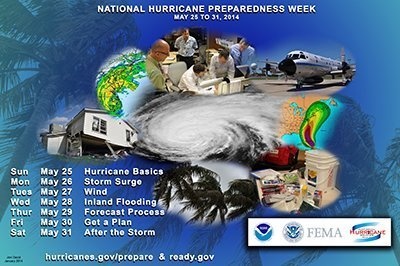
Georgetown, Del., May 22, 2014: Just as Delaware and the rest of the eastern United States are emerging from one of the harshest winters and wettest springs in recent memory, a new round of weather woes could be on the horizon – the 2014 hurricane season.
As the Atlantic hurricane season gets underway on June 1, the Sussex County Emergency Operations Center encourages residents and visitors to have a plan and be prepared now, when the weather is calm, before extreme weather comes this way. May 25 through May 31 is National Hurricane Preparedness Week, a time when coastal residents can learn more about preparing their homes and businesses for tropical weather.
Preparation is key to limiting damage and preventing loss of life, whether it’s for winter’s nor’easters and blizzards or the blazing heat and tropical systems of summertime, said Sussex County EOC Director Joseph L. Thomas.
“Despite some brushes with hurricanes over the past few years, especially Superstorm Sandy in the fall of 2012, Sussex County has been very fortunate to escape serious damage and injuries,” Mr. Thomas said. “But we can’t depend on luck forever. If a storm has its sights set on the Delmarva Peninsula, we all have to be ready in advance, and that includes emergency managers, public safety officials, as well as resident, property owners, business and visitors.”
For the 2014 Atlantic hurricane season, which begins Sunday, June 1, the National Oceanic and Atmospheric Administration is predicting a near- to below-normal year, with eight to 13 named tropical systems. Of those, three to six could become hurricanes, with one to two of those possibly reaching Category 3 strength or higher, according to NOAA’s May 22 forecast. An expected El Niño weather pattern – the warming of waters in the Pacific Ocean off South America – is expected to develop later this summer, causing wind shearing in the Caribbean and Atlantic that could inhibit the development of tropical systems in the Atlantic basin, according to the forecast.
An average Atlantic hurricane season sees 12 named storms, including six hurricanes, with three classified as major. Whatever the forecast, though, residents and property owners should never be lulled into a sense of complacency, Mr. Thomas said.
“All it takes is one storm to cause tremendous damage and take lives,” Mr. Thomas said. “It’s not a question of ‘if’ that could happen, but ‘when’ it will happen. So it is best for everyone to be prepared and never need an emergency plan than to be completely unprepared and be caught in a life-and-death situation.”
To help make the storm season safer for everyone, here are some steps you can take to make your home and family ready for hurricane season:
- If you live in a flood-prone or other vulnerable area, be prepared to evacuate. Plan your evacuation route now. Emergency managers will notify the public, via the media, of what areas should evacuate and when. In the event you evacuate, take a storm kit with you. Take valuable and/or important papers with you. Secure your house by locking the windows and doors. Turn off all utilities (gas, water, electric, etc.). Notify a family member or someone close to you outside the evacuation area of your destination.
- Secure all outdoor items. Property owners also will need to secure their boats. Area residents should clear rainspouts and gutters and trim any trees that may pose a problem during high winds.
- Have a family disaster kit. This kit should include the following items:
- A three-day supply of water. This should include at least one gallon of water per person per day;
- Non-perishable foods and a manual can opener;
- A change of clothes and shoes for each person;
- Prescription medicines;
- A blanket or sleeping bag and pillow for each person;
- Personal hygiene items;
- A flashlight and extra batteries for each person;
- Special needs items, such as formula and diapers for infants, as well as items needed for elderly or disabled family members;
- A portable radio with extra batteries;
- Money. During power outages, ATMs will not work;
- Fuel. Gas pumps are also affected by power outages, so it is a good idea to have fuel in advance.
- In the event of an approaching storm, travel during daylight hours. DO NOT WAIT UNTIL THE LAST MINUTE TO MAKE PLANS OR TO PURCHASE GASOLINE AND SUPPLIES. When a storm watch is issued, you should monitor the storm on the radio and television. An evacuation could take 24 to 36 hours prior to a storm’s onset.
- If ordered to evacuate and seek shelter elsewhere, follow the instructions of local emergency managers on where to go and when. Authorities will announce shelter locations in advance of their opening. Make provisions for your pets, as many shelters will not accept animals.
- If not ordered to evacuate and you decide to take shelter in your home, have your disaster kit ready. Keep your important papers with you or store them in the highest, safest place in your home, and in a waterproof container. Even if you seek shelter in place, you need to secure your home by locking the doors and windows. Turn off all utilities (gas, water, electric, etc.). Monitor the storm by portable radio to keep up with the latest information. Stay indoors. Try to stay in an inside room away from doors and windows.
- Use your phone sparingly. Make only essential calls and keep the calls brief. Report emergencies to 911. When reporting emergencies, identify yourself and your location, making sure to speak clearly and calmly. If you have a mobile telephone, make sure it is charged and ready to use at all times. Remember, however, that cell service may be interrupted during and after the storm.
Hurricanes and tropical storms can have devastating effects. In the event a hurricane affects our area, expect polluted water, limited communications, no electricity, overflowing or backed-up sewers, undermined foundations, beach erosion and heavy damage to homes and roadways.
Do not re-enter the area until recommended to do so by local authorities. As you re-enter the area, be aware of possible hazards such as downed trees and power lines. Be aware of debris and water on roadways. Upon re-entry, have identification and important legal papers ready to show officials proof of residency. Continue to use your emergency water supply or boil water until notified that the drinking water is safe. Take precautions to prevent fires.
###
For more information on preparing for hurricane season, including evacuation maps and preparedness brochures, visit sussexcountyde.gov/hurricane-information. Another helpful source is the NOAA Hurricane Preparedness Week homepage.

